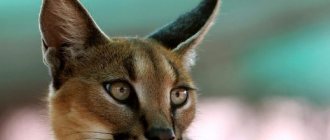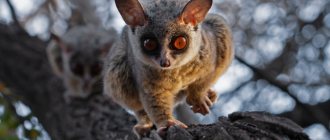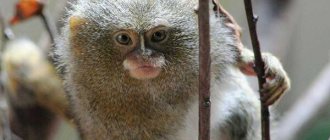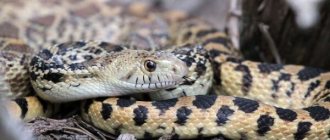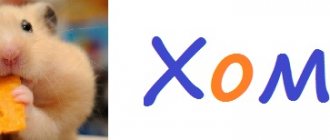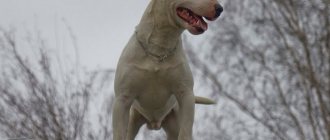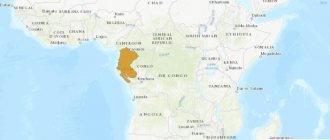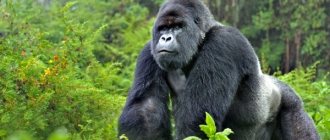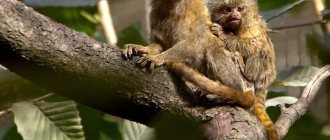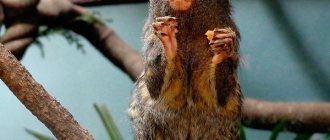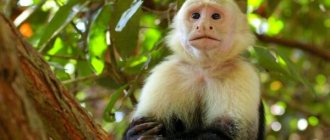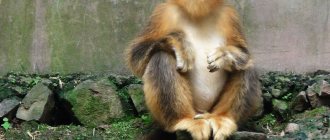- Wild animals
- >>
- Mammals
Mandrills are monkeys that are easily recognized by their unusual appearance. It seems that they have collected all the colors of the rainbow: from red to blue and green. These monkeys are unique because, as a rule, only fish or birds have this coloration.
Origin of the species and description
Photo: Mandrill
The mandrill (or "sphinx") is a member of the monkey family and the genus Mandrill. Previously, this genus was considered in the classification of baboons, but, in connection with recent research, it is now distinguished separately. Representatives of the monkey family are also called “dog-headed” or narrow-nosed monkeys. All names speak for themselves. The structure of the skull of such monkeys resembles the head of a dog, and the nasal cartilage is extremely small.
Video: Mandrill
The monkey family is very heterogeneous and is divided into two subgroups:
- the first is omnivorous monkeys, which includes mandrills. These primates are able to digest any food, are also prone to hunting and are the most aggressive;
- the second is monkeys, predominantly herbivores, although they can make a rare exception in favor of animal food. This includes langurs, proboscis monkeys, and fatheads.
Monkeys are a very common family. Due to their habitat and various characteristics of life, they have different sizes and colors, and differ slightly from each other morphologically. The family is distinguished on one common basis: the shape of the skull and the position of the skeleton. The skull is always elongated, with sharp long fangs. Monkeys move exclusively on four legs, with the front legs being more developed than the hind legs. The tail does not perform any function - monkeys cannot even move it.
Appearance and features
Photo: What a mandrill looks like
Mandrills are fairly large monkeys with obvious sexual dimorphism. Males are brighter and larger than females, have thicker fur, and have many unusual colors not typical of mammals. The height of the male at the withers is about 80 cm, the weight can exceed 50 kg. Females are no more than 60 cm tall, and their weight is approximately 15 kg. All mandrills have a short tail - only 3-6 cm - this is the shortest tail of the entire family of monkeys.
Interesting fact: Some female mandrills do not have a tail at all.
The mandrill's nose is bright red. Cartilaginous relief grooves running along it have a blue or light blue color. The fur on the face is orange, red or white, depending on the mandrill's habitat. Male mandrills, like baboons, have a pronounced ischial callus - it disappears by at least 10 cm. The peculiarity is that it is painted in rich, bright colors - from red to blue and purple. There is almost no fur on the back, so these colors are clearly visible.
Mandrills have thick fur, but they have no undercoat. These are thin, numerous hairs of a brown or dark brown hue. The neck and belly of monkeys are white, or simply lighter shades.
Mandrills move exclusively on four legs, which are developed enough for the monkey to be able to climb trees and run quickly. Male mandrills have a thick mane that frames their heads.
Both females and males have an elongated head with a distinct cartilaginous hump along the entire nose. When expressing emotions of aggression or yawning, you can see giant white fangs that are located on both jaws. The monkeys' eyes are small, under massive brow ridges - because of this, mandrills have an even more stern appearance.
GALAGO: A little monkey that can become a pet
Greetings, dear naturalists. Zoo channel is with you. We are collecting a large video encyclopedia about all the animals on the planet. Love nature with us, subscribe and let's go.
So, friends, today our guest is either a lemur, or a loris, or an African monkey named Senegalese galago - a primate of the galago family. They are the most successful and diverse wet-nosed primates in Africa. By the way, there is a video about the Madagascan ring-tailed lemurs in the playlist about animals of Africa.
Galagos are small, large-eyed primates native to the sub-Saharan Desert. They primarily live in dense, humid tropical forests and sometimes live in savannas. According to the official classification, galago belongs to the family of galago lemurs. However, previously they were classified as a subfamily (Galagonidae) in the Loridae family.
Indeed, these cute animals are very similar to loris lemurs and are even evolutionarily close to them, but galagas are more ancient. Galagos are also much faster than lorises and usually hunt by chasing prey.
Galagos are the most numerous primates in Africa and are found in almost every major forested area on the continent.
Galagos weigh up to 300 g. The fur is thick and fluffy, brown on the back, and the belly is white to light brown. The head is round, the eyes are very large, adapted to a nocturnal lifestyle. Hairless and mobile ears are also large. The tail is longer than the body and bushy at the end. The hind limbs are strong, the second toe has a claw for preening and grooming. By the way, under the tongue these animals have a special bulge that resembles a second tongue; together with the front teeth, this tongue is also used in caring for fur.
Galago simply means "monkey" in African language. These primates are also called Senegal Bushbaby, which translates as “Bush Baby”; primates received this name for their small size and child-like appearance.
By the way, galagos are quite tolerant of temperature changes, and temperatures from -6 to +41 degrees are suitable for their life.
Galagos are nocturnal primates, with the help of their large eyes they are able to see perfectly in the dark of forests. If galagos are awakened during the day, they will move extremely slowly.
During the day, they sleep in the thick of plants, in abandoned bird nests or in tree hollows. At night they go in search of food, climbing vertically, jumping and covering distances of up to 5 meters.
The diet of galagos is very varied, including small live prey (insects, small vertebrates and eggs), fruits, nectar and flowers. They drink tree sap. Well, we are birch.
When hunting insects, galagos rely on their large ears. They catch prey on the fly with their hands and by squeezing it with their toes.
Galagos are territorial animals. Males usually live in territories that partially occupy the community sites of females, while protecting their females from other males. Do you know how they mark their goods?
Galagos pee on their palms and then move along tree branches. Such tracks create a semblance of paths along which they easily move at night. Males also urinate on females to mark them. I wonder if females don’t mind such a mark?
Galago, like all monkeys, is very talkative. In their repertoire, scientists identify about 20 different calls. The most characteristic of the species is a piercing single cry, which galagos can emit for an hour. The cries of the male and female, emitted during courtship, are very reminiscent of a child's cry, which is perhaps why the galago is called “bush baby”.
When communicating with galagos, visual communication is also very important, for example, a gaze means a threat. There is also tactile communication: nose-to-nose greetings are followed by grooming or play. During such a greeting, individuals approach each other and “kiss” the tips of their faces.
Speaking of kissing. Galagos, like all Loriids, have a bone in the penis, and backward-pointing spines protrude from the skin at its end. This promotes long-lasting mating and ensures its success. By the way, this bone and spines differ in different species, preventing interspecific crossings. These are monkeys with a secret.
Reproduction in Senegalese galagos occurs 2 times a year - in November and February. In captivity they can breed throughout the year. Females make nests from leaves, in which, after 125 days of pregnancy, 2 cubs appear; less often, there may be three or one babies.
Newborn galagos are physically weak. They cannot hold on to their mother’s coat themselves, so in the first days of life the mother carries the babies in her teeth, holding them by the scruff of the neck, sometimes leaving them in a hollow or in a fork in the branches. At 2 weeks they are already moving slowly on their own, and during long journeys they ride on their mother’s back, holding on to the fur. At 3 weeks, babies are able to move along branches. At 17-20 days they begin to eat solid food. Sexual maturity in Senegalese galagos occurs at 7-10 months.
Mothers continue to care for their babies for 3.5 months. Galago fathers do not care for their offspring. Young males leave the family, and females remain with their mothers, forming related social groups in which they live with their cubs.
Well, and finally, I’ll say that if you are a lover of exotic animals, then galago is quite suitable for keeping at home. He will delight you and amuse all family members with his presence. How do galagos behave in an apartment?
Galagos are agile and love to jump and climb a lot. In the wild, they constantly move between tree branches
In principle, you can also do without an enclosure, but it is very difficult to toilet train galagos. In addition, they constantly mark their territory.
Don't forget that galagos love warmth. Despite the fact that they are nocturnal animals, they are extremely cautious and move quietly, so you can rest easy and sleep peacefully. Galagos quickly get used to home life and practically do not get sick.
The lifespan of galagos in captivity is 15-20 years.
Well, what did you like about these wet-nosed monkeys? Would you get one like this? Write in the comments.
By the way, at the same time I ask you to write about which animal you would like to see in the next video.
Thank you for watching this video. Don't forget to like and share this video with your friends, it really helps the development of our small community. There was a channel about animals Zoo with you. We are collecting a large video encyclopedia about all types of animals on the planet. Love nature with us. See you soon.
Where does the mandrill live?
Photo: Mandrill Monkey
The mandrill has long been considered the baboons' closest relative, but evidence of interspecific interbreeding has shown that this is not the case. Mandrills and baboons are rarely found in the wild due to their different habitats.
Mandrills inhabit the following areas of West Africa:
- Gabon;
- southern Cameroon;
- settle near the Congo River.
Unlike baboons, mandrills prefer tropical deciduous forests. These monkeys are more adapted to climbing trees. They often feed while sitting on thick branches high above the ground. Although mandrills predominantly lead a terrestrial lifestyle. It is rare to see small groups of mandrills or solitary individuals in the savannah. These are males expelled from their packs and united in young groups. If mandrills go out into the savannah, it means they were unable to carve out new territories for themselves in the rain forests. Such mandrills, as a rule, do not survive.
Even despite their impressive appearance and aggressiveness, they face active resistance from baboons, and also become victims of hunting by large predators. However, it is precisely thanks to the entry of mandrills into the savannas that interspecific crossing with hamadryas and baboons occurs. They produce offspring that are also capable of reproducing. This practice is actively used in zoos.
Now you know where mandrill monkeys live. Let's see what they eat.
What does a mandrill eat?
Photo: Baboon mandrill
Mandrills are omnivorous and voracious.
The daily diet of animal food must include:
- protein insects - ants, termites, larvae, grasshoppers;
- snails and even poisonous scorpions can be eaten by mandrills;
- small rodents, frogs, birds;
- bird eggs and hatched chicks.
Interesting fact: Mandrills are comfortable with eating leftover plant food after other animals. For example, nimble monkeys climb to heights where mandrills cannot reach and accidentally drop bitten fruits or pieces of fruit, which the mandrills then eat.
Mandrills are capable of active hunting. If any equid animal comes too close to their flock, the mandrill can rush to attack and easily kill it with the help of its huge fangs. Then there will be enough food for the whole flock. However, these monkeys disdain carrion. They will not finish eating animal food due to various predators, but will prefer to feast on plants.
For example, a mandrill's plant diet may include:
- various fruits;
- green leaves;
- seeds and roots;
- nuts;
- soft bark, thin branches, plant stems.
Plant foods make up more than 90 percent of a mandrill's diet. They easily cope with the hard shell of nuts and willingly peel the skins of fruits - not only their fangs help them in this, but also their developed fingers. In captivity, dried fruits, cottage cheese, various cereals, boiled meat, eggs and vegetables are added to the diet of these primates.
Features of character and lifestyle
Photo: Mandrill Primate
Like baboons, mandrills live in large families of up to 30, less often - 50 individuals. Everyone in the pack is related. There are always more females in a flock than males, and a significant part of the females are always with small cubs. The pack is led by an alpha male, who controls the observance of a clear hierarchy. These monkeys are purely territorial animals and do not accept nomadism. They move to another place only in conditions of serious lack of food, water, or when there is a dangerous threat to life.
The fact is that in the wild, each pack has a territory of approximately 50 square kilometers, and violating the boundaries can lead to bloody clashes with other packs. On the other hand, if there is very much food, then families can unite, forming flocks of up to two hundred animals. When the food runs out, the flock again breaks up into families and disperses to its own territories.
Baboons are diurnal. In the morning, adult individuals go in search of food: they carefully examine the foliage, turn over stones, and climb onto low tree branches. After breakfast, they gather in small groups for grooming - an important ritual for monkeys that demonstrates the hierarchical relationships within the troop.
Mandrill cubs spend most of their time playing, during which they learn the nuances of survival. Low-ranking males may periodically conflict with each other, but no one encroaches on the right of primacy of the leader. The leader must choose places for feeding and regulate intra-family conflicts. Mandrills have a developed sound system based on body movements and sounds, but the leader prefers to use brute force. Some young males may engage in confrontation with the leader in an attempt to seize power. This is only possible if the male is already old and cannot give a full fight.
Man with Monkey Balls
≡ 5 January 2016
← How to protect your husband from masturbation
O-rings and car repair kits at a very good price →
At the beginning of the twentieth century, the First World was overwhelmed by a passion for remaking man. The results were not slow to appear: the Russian-French subbotnik Voronov and the Austrian Steinach carried out hundreds of transplants of monkey testicles into people for the purpose of rejuvenation. But in the 1940s, for ethical reasons, these experiments were prohibited.
The fixed idea “we cannot wait for favors from nature, taking them from her is our task” (breeder Ivan Michurin) is mistakenly associated only with the young Soviet government. Mikhail Bulgakov’s “Heart of a Dog” (especially the film of the same name) goes into the same piggy bank, from which a not very educated person draws a conclusion about the stupidity of the Bolsheviks. The well-read intellectual also heard something about the early Soviet attempts to crossbreed a monkey and a worker, and now the cliché is ready: “Freaks!” But all this Soviet experience in remaking people is only a tiny part of what was done to people in the West. And not out of stupidity or malice, but because of faith in the omnipotence of science. Almost everything that humanity uses today and mistakenly considers to be the creation of modern scientists was invented between 1870-1930. The internal combustion engine and the electric car (descendants have not reached it even a hundred years later), communications, television and cybernetic machines, electricity and the basics of mass production of goods, selection of animals and plants. 95 percent of the material world around us is all inventions of a century or more ago.
The last thing that science has not reached is man. We are still subject to the laws of nature and have almost no power to change it. But not due to mediocrity, but due to ethical restrictions.
The first experiments in human “improvement” at the beginning of the twentieth century gave quick and excellent results. It (the result) did not have to be put under a microscope to be convinced of the effectiveness of the scientists’ manipulations. Two great doctors of the time - Sergei Voronov and Eigen Steinach - demonstrated the results of their experiments in crowded classrooms, and the audience applauded them.
(Sergey Voronov)
Both scientists worked on human rejuvenation, and the leader here was Sergei Voronov.
Sergei (Samuel) Abramovich Voronov was born in 1866 in Voronezh, into a family of subbotniks - a Russian subethnic group that professed Judaism since the 17th century. Tsarism still somehow tolerated Jews, but Russian Judaists were the most oppressed religious group in the Russian Empire (“betrayed the faith of their fathers”). Therefore, it was not surprising that Sergei Voronov moved to France permanently in 1884 with his family. In 1893 he received a higher medical education. In 1896 he went to Egypt, where he became one of the attending physicians of the Khedive (the title of the head of state in 1867-1914).
(Voronov family, still in Russia)
In Egypt, Voronov found excellent biological material for his experiments - slave eunuchs. They were castrated at a very young age of 6-7 years. As they matured, these men acquired effeminate body shapes. They had wide hips and narrow shoulders. The beard didn't grow. Eunuchs had low intelligence and poor memory. Similar patterns led Voronov to the conclusion that the formation of muscle mass, skeleton, and mental development is directly influenced by the gonads.
The young doctor also found that castrati grew old quite quickly, turned gray and did not live to a ripe old age. This is what prompted Sergei Abramovich to think about rejuvenating the body: if the seminal glands from a young full-fledged man were injected into an aging eunuch, then the castrato’s body would be rejuvenated.
He later recalled that he immediately began experiments with transplanting glands from monkeys to people. But evil tongues claimed that the Egyptian satraps allowed him to experiment with people sentenced to execution (disassemble them for organs). However, Voronov was a smart man, and he understood that he still had to train his hand on monkeys - in Europe, the Egyptian number with suicide bombers would never have worked.
(Illustration in a magazine about Voronov’s experiments in Cairo)
In addition, in his view, monkeys were better than humans for ethical reasons: they did not have negative heredity, were not prone to alcohol, tobacco, child molestation and other unsightly qualities of human nature.
In 1912, Voronov performed his first operation in Europe. He transplants a chimpanzee's thyroid gland into a human suffering from thyroid disease. After this, the patient feels noticeably better, and this success inspires the experimenter.
The next patient is a 14-year-old boy suffering from mental retardation. Sergei Abramovich took the thymus gland of a monkey and vaccinated the boy. “At the time of the operation he was a complete idiot and gave the impression of being eight years old - the age at which the disease took hold of him. On December 5, 1913, with the presence of 19 doctors, he transplanted the right lobe of the baboon's thyroid gland. The effect is amazing, the boy grew up and recovered so much that he could get an education, and in 1917 he was declared fit for the front,” Abramov wrote.
(The result of Voronov’s experiments is obvious)
Since 1920, Voronov began to specialize in testicular transplantation. He made thin sections on the chimpanzee's testicles and sewed them into the patient's scrotum. During the first operation, the human body accepted a foreign body. It grew into the testicles of a 65-year-old patient. “He became noticeably fresher, the wrinkles on his face smoothed out, plasticity and energy appeared in his movements,” described Voronov.
During these same years, in parallel with Voronov, the Austrian surgeon Eigen Steinach was engaged in the same experiments, and he also transplanted glands from person to person. The magazine "Krasnaya Niva" in 1921 described his practice as follows:
“After Steinach obtained amazing results on animals, he could consider himself entitled to transfer them to humans. The first operation he performed, together with his young colleague, surgeon Lichtenstern, was to restore potency and male characteristics to castrati. The first person to undergo this operation was a military man who had both testicles removed due to injury during the war. Just a few months after this, he showed signs of castration: obesity, hair loss, loss of sexual ability, general indifference and exhaustion. In 1916, Lichtenstern implanted a cryptorchid testicle into him, after which the patient’s sexual sense returned, muscles, hair growth, etc. increased. The subject got married and enjoys family happiness, according to the latest data so far, i.e. already 5th year.
(Eigen Steinach)
(Cryptorchid or “inguinal” are testicles that, due to still unclear conditions of embryonic development, do not descend into the scrotum, but get stuck in the groin. Such testicles often cause pain and are sources of dangerous tumors, as a result of which they have previously been removed and thrown away)
After that, Lichtenstern described two more similar cases, and in 1918 - the first case of surgical treatment of a homosexual: the patient’s own bisexual testicles were removed and a cryptorchid was implanted from a normal sexual subject.
Finally, Steinach describes 3 cases of rejuvenation of old people. In these three cases, the significant fact is that all three patients did not know about the nature of the operation they underwent when all the objective signs of rejuvenation began to appear in them: they did not turn to the doctor for rejuvenation, but with some other diseases and ailments. Thus, any possibility of suspecting self-hypnosis is excluded here.
The first case concerns a laborer, 44 years old, but with all the signs of premature old age. He came to the doctor because of general weakness of the body and pain in both testicles. Very thin, weak, flabby muscles, face with wrinkles.
He is incapable of physical labor and has had no sexual desire for several years. Pain in the testicles turned out to be a consequence of bilateral testicular hydrocele.
On November 1, 1918, he underwent an operation: opening of both testicles; simultaneously bilateral ligation and transection using the Steinach method.
4-5 months after this, the patient, as a laborer, carries loads weighing up to 100 kilos on his back. He arrived in weight, his face smoothed out. Potency at the height of stormy youth, hair growth on the head, hips and pubic area, shaving more often. A year later, he gained 12 kilos in weight.
2nd case. A 70-year-old man, the head of a large enterprise. He was taken to the sanatorium with an abscess of the left testicle. His left testicle was removed and at the same time a bandage was made on the right side.
This is how, several months after the operation, the patient himself described his condition in a letter to Lichtenstern (it is characteristic that at the time of writing this letter he still had no idea about the nature of the operation performed on him): “After the wound healed, I began to look for resting places so that gather strength. Already there, to my extreme surprise, I had erotic dreams at night in a supine position and, in connection with them, wet dreams. My appetite has degenerated into real gluttony, and even now, in these difficult times, I am barely able to satisfy the needs of my stomach. Whereas previously I was in a state of deep spiritual depression, I have now been cheerful again for many months. My look is fresh again and I am very flexible for my age. The people with whom I am now again entering into relations consider me barely sixty years old and doubt that I have reached the 71st year of my life. Previously, when I walked a little fast or climbed a slightly steep road, I had to fight heaviness and shortness of breath: now this has almost completely stopped and I am often on my feet for an hour.”
The 3rd case concerns a 66-year-old merchant who suffered for 5 years from severe fatigue, loss of mental strength and memory, difficulty breathing, etc. On November 12, 1919, an operation was performed. 1/2 year after this, he gained 7 kilos in weight, his memory and mental alertness were restored, and the typical signs of decrepitness (shortness of breath, pain in all limbs) disappeared. Libido restored."
(The result of the operation performed by Voronov is obvious)
Both doctors put the matter on stream. Dozens of people flocked to them for rejuvenation, and if not for the high fees for the operation, there would have been thousands of patients.
From 1921 to 1924, Voronov performed 56 operations. All of them had a beneficial effect on the health of patients.
In 1923, a surgical congress was held in London. It brought together luminaries of medical science from Europe and America. Voronov's speech was the main event of such a serious event. Time magazine described it as a "triumph".
Sergei Abramovich stated that he operated on 238 people aged 55 to 70 years (including Egyptian experiments). In 90 cases out of 100 the result was positive. In people aged 70 to 85 years, the data were slightly worse. 19 people were operated on. The most important functions of the body, including sexual function, were restored in 11 patients.
The medical luminaries were particularly impressed by the case of a certain wealthy Englishman. Tom was 74 years old, but he looked like he was 85. Voronov sewed a baboon testicle into his scrotum. The old man, with his pants down, happily twirled around in front of the audience.
(The result of the operation performed by Voronov is obvious)
Voronov becomes a celebrity and also a millionaire. The demand for operations was such that he had to create a monkey nursery in the south of France, at Grimaldi Castle. In 1927, Voronov declared that “soon in Europe and America there will be no fewer monkey nurseries than Ford factories.
Rejuvenation through transplantation of monkey testicles is of such interest to the public that it is even reflected in popular literature. With an interval of two years, two works were published, written by professional doctors who were also great writers - Arthur Conan Doyle’s story “The Adventures of a Crawling Man” (1923) and Bulgakov’s “The Heart of a Dog” (1925).
Similar experiments are also underway in Russia, and the doctors who conducted them become the prototypes of Bulgakov’s work. The character "Dr. Burmental" is Dr. Rosenthal, the head of one of the three laboratories under the great physiologist Ivan Pavlov. “Professor Preobrazhensky” is Professor Voskresensky from the rejuvenation laboratory in Tver.
Here, for example, is what the newspaper “Krestyanskaya Pravda” wrote on January 12, 1924 about Voronov’s followers in a note entitled “Rejuvenation”:
“The continuers of the case of Steinach and Voronov are Professor Voskresensky and Doctor Uspensky, who have special institutions in Tver. They do their work on people too. In a year and a half they rejuvenated: 10 workers, 5 doctors, 2 priests, 1 merchant and more than 15 Soviet employees. The material for the operations is provided by the monkey nursery. Most people who have undergone surgery feel quite well, are alert and productive. For some of them, wrinkles disappeared and hair began to grow in place of their previous bald spot.”
In 1925, Voronov’s book “Rejuvenation by Grafting” was published, in which the doctor described the expected effects of testicular tissue transplantation: improved memory, high performance, no need for glasses (due to strengthening of the eye muscles), prolongation of life and increased potency. Voronov was also involved in transplanting monkey ovaries to women. He also conducted reverse experiments on transplanting a human ovary into a monkey and artificially inseminating the monkey with human sperm, although without success.
(Voronov’s monkey nursery in his Grimaldi castle in Provence)
By the early 1930s, several thousand very wealthy people had undergone “rejuvenation,” including Harold McCormick, chairman of the International Harvester Company, and the aging Prime Minister of Turkey Ataturk. Voronov’s patient was also the French Prime Minister Georges Clemenceau.
At the same time, with the growth of right-wing and pro-fascist sentiments in France, attacks on Voronov intensified. He is accused of disregarding human morality, and accusations are immediately poured in that he is an NKVD agent. Voronov moved to the French colony of Algeria, where it was a little calmer.
In 1940, the Nazis occupied France, and the Vichyists under their control confiscated all the equipment of Voronov's laboratory, all his archives and documents located in his palace on the Cote d'Azur. He also had to flee from Algeria to neutral Switzerland. There, local authorities categorically forbade him to engage in “rejuvenation”, and until the end of his days - in 1951 - Voronov was an ordinary pensioner. He lived to be 85 years old.
(Pogrom in Voronov’s laboratory, 1940)
Around the same years - in the early 1930s - the Stalinist regime ruled, and therefore experiments with organ transplants from monkeys to people stopped. Moreover, the main enthusiast of these practices, Dr. Ilya Ivanovich Ivanov, died in 1932.
It was Ilya Ivanov’s experiments that became fiction in the USSR, growing in speculation every year. Ivanov allegedly bred a “hybrid man” - half-man, half-ape.
(Ilya Ivanovich Ivanov)
“In 1926, Stalin supported a secret plan to create in the laboratory creatures with incredible strength and an underdeveloped brain, insensitive to pain, hardy and unpretentious in food. It was assumed that it would be possible to grow a “living military machine”, and at the same time a “workhorse”, which could be exploited in coal mines, construction in Siberia and the Arctic regions without great expense,” - this is how Ivanov’s experiments are speculated today. It doesn’t even occur to people that this “hybrid” was tens of times more expensive than the “workhorse” in the form of a Russian peasant. The semi-monkey had to undergo an operation - this required hundreds, if not thousands of highly qualified doctors (by the end of the 1920s there were at least a dozen in the USSR). It was necessary to wait 5-6 years until the “hybrid grew up”, feed and protect it. Why all this, when it was possible to pull out a million or two peasants and send them to shock construction sites and or to the heat of battle. Free and angry. Under Stalin, 80% of the population were “hybrids”.
(An article about Ivanov’s experiments, by clicking on the picture you can see it in an enlarged size)
No, Ilya Ivanov was engaged in the same experiments as Voronov or Steinakh - rejuvenation, replacing a diseased human organ with a healthy monkey one. It was for these purposes that a large monkey nursery was created in Abkhazia.
If Dr. Ivanov was so needed by Stalin, then he would not have received 5 years in the camps in 1930 for “counter-revolutionary activities”, however, they were replaced by exile to Alma-Ata. Where he died at the age of only 62 years.
Tags: health • history • people • medicine • youth • science • experiments • educational • fascinating • people
Comments:
Comments for the site Cackl e
Social structure and reproduction
Photo: Mandrill from the Red Book
Mandrills have a mating season that falls between July and October. This is a period of drought when mandrills cannot actively feed and reproduce. The dominant male mates with all females who do not have cubs and are of reproductive age. Females do not have the opportunity to mate with another male. The male has several alpha females, whom he covers first. These females regulate relationships between other females in the pack and help everyone look after the young.
Interesting fact: You can tell if a female is ready to mate by the intensity of the color of her ischial callus - the redder it is, the more ready the female is to give birth to a calf.
The gestation period lasts eight months, during which the female goes about her business without experiencing discomfort. Childbirth takes place quickly, but older females help younger ones by providing emotional support. The female gives birth to one, less often – two cubs. The female immediately puts the newborn primate to her breast, feeding him with rich milk. For the first three weeks, the cub travels clinging to its mother's belly. As soon as he learns to eat plant foods, the cub will move to his mother’s back.
Children are raised by the whole team. Females can take other people's cubs to feed - this is especially important if a female with a small cub dies. Monkeys become completely independent only by the third year of life, but even then their attachment to their mother remains. Adults often come to their mothers for the night and sleep next to them. Grown-up females become the “wives” of their father-leader, and grown-up males leave the family, creating their own groups. Sometimes some females may follow them. In this situation, the alpha male will try to fight off the female, forcing her back. But often females can show similar counter-aggression, as a result of which the leader calmly lets them go after the young male.
Bornean orangutan
Height – 100-150 cm, weight – 50-100 kg.
The Bornean orangutan lives on the island of Borneo and spends its entire life in the branches of the local tropical forests. He practically never comes down to the ground, even to drink. He has a protruding muzzle, long arms and hair that grows so long in old age that it resembles matted dreadlocks.
Males have pronounced occipital and sagittal crests and fleshy growths on the face. The orangunang feeds mainly on plant foods, ripe fruits, tree bark and leaves, and honey. A distinctive feature of these animals is their solitary lifestyle, which is not typical for primates. Only females can be in the group during the period of feeding their cubs.
Natural enemies of the mandrill
Photo: Mandrill
Mandrills live in dense, humid forests, where they are perhaps the largest predators. Their imposing appearance, aggressiveness, noisiness and long fangs make them dangerous opponents.
There are not many predators they face:
- leopards. This is the most dangerous predator for mandrills. He can ambush monkeys right on a tree. The leopard quickly kills the primate, biting its neck and not allowing it to offer counter resistance. After killing him, he drags the monkey up a tree where he eats it. If a leopard is spotted in ambush, the monkeys make a noise and scatter into the trees. The leader, in turn, must rush at the leopard, protecting his family. Often this ends in the death of the leader, but leopards never die from mandrills, fleeing in case of extreme danger;
- pythons. Large snakes readily feast on growing mandrills. They are difficult to spot in ambush among the foliage. Particularly large snakes can strangle even an adult female, swallowing her whole. Monkeys actively fight back against pythons: if a snake grabs a baby, the mother will beat it and tear it apart with her hands in order to save her child;
- some large birds. They attack mandrills least often, since mandrills lead a predominantly terrestrial lifestyle, and birds of prey prefer to hunt by grabbing monkeys from tree branches. However, baby mandrills are at risk when they climb too high out of curiosity.
Population and species status
Photo: What a mandrill looks like
The mandrill is listed as endangered in the Red Book. Although the monkey population is huge, it has declined by forty percent over the past thirty years. Mandrills, like baboons, are pests. They may settle near villages where they begin to steal small livestock. Also, by rummaging through garbage, mandrills become carriers of dangerous diseases. Due to their aggressiveness and large size, collisions between people and mandrills sometimes resulted in serious injuries to humans or even death. All this led to people exterminating mandrills.
Interesting fact: The largest flock lives in the Gabon National Park - it numbers about one and a half thousand mandrills. They united on a permanent basis and have not broken up for several years.
Massive deforestation is destroying the monkeys' natural habitat. Because of this, cubs and young individuals die. Families are forced to switch to a nomadic lifestyle, looking for a new food source, since deforestation leads to a reduction in many plant and animal species that mandrills feed on. Mandrill meat is considered a delicacy among the Gabonese population. This did not have a major impact on the population, but contributed to the extinction of mandrills.
Lowland gorilla
Height – 150-180 cm, weight – 70-140 kg.
This is a fairly common species of gorilla that lives in Angola, Cameroon, Congo and some other countries. Lives in mountain forests, sometimes swampy areas.
It is representatives of this species that in most cases live in zoos, and the only known albino gorilla also belongs to its lowland counterparts.
Gorillas are not jealous of the boundaries of their territories; communities often intersect. Their group consists of a male and females with their cubs, sometimes they are joined by non-dominant males. The number of lowland gorillas is estimated at 200 thousand individuals.
